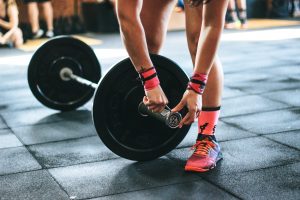
The Lifter’s Guide to Warming Up
The Lifter’s Guide to Warming Up Warming up is like saving for retirement. We all know it’s important, but we don’t exactly know why or

Growing up, you’ve heard the fitness industry tell you building more muscle will boost your metabolism therefore allowing you to eat more food without fat gain.
Fast forward a decade later to present day and coaches are now saying the opposite. They’ll regurgitate contextless statistics about how an extra 20 lbs of muscle will only boost your metabolism by a pathetic 100 calories thus not really making a difference.
But is this entirely true? This is a topic I think most coaches haven’t explored deeply enough; they simply base their opinion on what other oversimplified coaches say.
Despite their current view that additional muscle doesn’t really allow you to eat more, these coaches are often able to eat a ton of food. It’s quite common for coaches and fitness enthusiasts to eat ice cream, pizza, peanut butter, or pasta daily without repercussions.
On the contrary, their clients must make bigger sacrifices to fit even small amounts of these foods in their macros.
These coaches preach to their clients that to eat more like them, their clients simply have to move more. 10,000 steps per day is the cliché recommendation, which is definitely useful, but it’s merely a fraction of the story. In fact, many coaches don’t even get 10,000 daily steps.

Allow me to give you some insider secret. Any coach (myself included) can easily point to a large handful of their clients who walk tens of thousands of steps per day and work harder than they do, yet can’t eat past 1500 calories without fat gain.
So why is that the case? I can tell you now, it’s not because coaches are ridiculously active people even though it may seem that way. We’re not much more active than the average client and usually less active than our most dedicated clients.
Many of us coaches only workout 3-4 times per week, train a few clients daily, and work online most of the day. And after work, we’re glued to the couch, binging the latest Netflix series like everyone else. So despite similar or even lower activity levels, how can fit people get away with eating piles of calories while most general population clients easily balloon up if they even attempt to fit more than 1 donut into their macros?
The answer is simple. Muscle mass. Despite popular belief, more muscle does allow you to eat more. It may not be a family feast overnight, but each additional pound of muscle is more significant than what current perspective would have you believe. Let me explain.
Gaining muscle mass is one of (if not, the only) viable proposed way to boost your metabolism. However, one infamous 14-week study in Rugby players made everyone think this couldn’t be possible (1).
After 14 weeks of in season training, Rugby players who gained 2 kg of muscle and lost half a kg of fat saw no statistical difference in their metabolism.
However, we clearly know total bodyweight and body composition correlates with your metabolism and activity energy expenditure (2,22). The more mass you carry, the more it costs to maintain that mass, especially muscle because muscle is more metabolically demanding than fat tissue (3,4,5).
In addition, losing muscle clearly drops your metabolism (18).
A more applicable study is one done in elite youth basketball players (6). This study is 34 weeks long where participants gained 4kg of muscle on top of losing fat. This timeframe is more realistic and with double the amount of muscle gained, we’re more likely to see an effect on metabolic rate if there is one.
Furthermore, unlike the Rugby players, the youth basketball players closer resembles the average person looking to build muscle and hopefully grow into a body that boosts their metabolism. The Rugby players were already near their genetic maxes. They were well over 200 pounds with a resting metabolic rate of about 2400. That’s how much they burned daily, not counting any exercise, so it’s not a big deal if their metabolisms didn’t increase after 2 kg of muscles.
But anyways, after 34 weeks of in season training, the basketball players boosted their metabolism which was solely attributed to muscle gain. Their metabolism burned an extra 200 calories per day and their total daily energy expenditure increased by 433 calories.
200 calories extra per day isn’t massive, but It’s not small either. That’s an extra scoop of ice cream daily. However, 433 calories is definitely noticeable. That’s almost 2 extra slices of pizza each day. This brings me to my next point.
So your resting metabolism might not skyrocket, but total energy expenditure compounds for a number of reason.
For starters, your tissue is not only calorically expensive at rest. With more mass, all activity done becomes more expensive (17).
We’re often taught expensive is a bad thing, but in the case of human metabolism, you want an energetically expensive body because it’ll cause your body to essentially pay up or burn more calories (thus allowing you to eat more food at the same energy balance).

Here’s an example.
Kyle is 130 lbs while Chad is 170 lbs (an extra 40 lbs of muscle). Let’s say Kyle and Chad ran a mile at the same speed. They both did the same work at the same intensity, but guess who burns more calories? Chad did because it costs more energy (aka calories expended) to power a bigger person. Just like powering a Tesla to move 10 yards requires more energy than it takes for a remote control car to move the same 10 yards.
Heck, more muscular people even burn more calories from something as simple as shivering (16).
In addition, more muscle allows to do more total work which will burn more calories. Let’s say Kyle and Chad both do 1 set of 12 to failure on the bench press. For Kyle, he hypothetically lifts 135 before hitting failure at rep 12. Chad on the other hand is much stronger because he has more muscle, so he’s hypothetically able to lift 235 before hitting failure at rep 12.
They both did 1 set with the same number of reps at the same failure point, but Chad still did more total work which requires more energy expended. Imagine over the course of many sets and many workouts how much this will add up for Chad.
Having more muscle doesn’t just increase energy expenditure, but the very process and means of building muscle costs a lot of energy.
To build muscle properly you have to progressively strength train.
Strength training in of itself raises your metabolism both long term and temporarily for 3 days after each session also known as post exercise oxygen consumption (7). In support of this, a 2020 meta-analysis found only strength training interventions significantly boosts metabolic rate by about 100 calories per day (8).
Cardio doesn’t have the same effect. Even with more total exercise, a combination of strength training plus cardio couldn’t reach statistical significance.
Furthermore, as you strength train and get stronger, you’ll lift heavier weights for more reps which continues to compound more calories expended over the course of your training journey.
In addition, at a cellular level, optimal strength training converts slower twitched fibers to faster ones along with triggering tons of protein turnover (protein breakdown and buildup), all of which costs more energy (9-13).
On top of all this, bigger muscles store more sugar otherwise known as glycogen, anywhere between 350-700 grams, allowing more muscular people to have a bigger safety net for carb intake (14).
Thus, it’s not surprising when we look at data where muscular people burn 350 additional calories at rest compared to people of the same height and bodyfat percentage (15). The raw absolute amount of muscle is what makes the difference.
In every model comparing metabolic rate, raw muscle mass always makes a difference (19,20,21).
So while muscle’s isolated effect on your resting metabolic rate is relatively minor, the practical difference is much larger, although difficult to tangibly sum up.
For example, let’s say you put on 20 pounds of raw muscle which is no easy feat. Oversimplified coaches will tell you that only amounts to an extra 50-100 calories expended through your resting metabolism.
But what people don’t understand is the very process of getting there costs a ton of energy from lifting bigger weights, strength training’s post exercise elevation in metabolism, and all the protein that your body has to turnover.
In addition, with every pound of muscle you gain, your body now costs more energy per movement, can perform more work, and possess higher glycogen storage capacity.
All these factors are small separately, but compounds together like an impressive retirement account. You might not notice much difference at first, but after a few committed years of muscle growth the effects will snowball into significantly more calories burned.
This is why, the most muscular people you observe can afford such flexibility with their food. They don’t have to walk 10,000 steps per day just to fit a cookie into their macros, but if they did, they could get away with eating 3 more. With enough muscle, an inactive day is not as detrimental and an active one gives you exponential leeway with your calories.
The good news is, anyone can start building more muscle. The bad news is, people generally don’t commit long enough to build a substantial amount. If you need help, I have plenty of other muscle building related articles on this site or feel free to email me with further questions ([email protected]).
1 MacKenzie-Shalders KL;Byrne NM;King NA;Slater.
“Are Increases in Skeletal Muscle Mass Accompanied by Changes to Resting
Metabolic Rate in Rugby Athletes Over a Pre-Season Training Period?” European
Journal of Sport Science, U.S. National Library of Medicine, pubmed.ncbi.nlm.nih.gov/30614386/.
2.
Hall, Kevin D, et al. “Energy Balance and Its
Components: Implications for Body Weight Regulation.” The American Journal of
Clinical Nutrition, American Society for Nutrition, Apr. 2012,
www.ncbi.nlm.nih.gov/pmc/articles/PMC3302369/.
3.
Wang, ZiMian, et al. “Evaluation of Specific
Metabolic Rates of Major Organs and Tissues: Comparison between Nonobese and
Obese Women.” Obesity (Silver Spring, Md.), U.S. National Library of Medicine,
Jan. 2012, www.ncbi.nlm.nih.gov/pmc/articles/PMC3319030/.
4.
EZ Zurlo F;Larson K;Bogardus C;Ravussin.
“Skeletal Muscle Metabolism Is a Major Determinant of Resting Energy
Expenditure.” The Journal of Clinical Investigation, U.S. National Library of
Medicine, pubmed.ncbi.nlm.nih.gov/2243122/.
5.
Heymsfield SB;Gallagher D;Kotler DP;Wang
Z;Allison DB;Heshka S; “Body-Size Dependence of Resting Energy Expenditure Can
Be Attributed to Nonenergetic Homogeneity of Fat-Free Mass.” American Journal
of Physiology. Endocrinology and Metabolism, U.S. National Library of Medicine,
pubmed.ncbi.nlm.nih.gov/11739093/
6.
Silva AM;Santos DA;Matias CN;Rocha PM;Petroski
EL;Minderico CS;Sardinha LB; “Changes in Regional Body Composition Explain
Increases in Energy Expenditure in Elite Junior Basketball Players Over the
Season.” European Journal of Applied Physiology, U.S. National Library of
Medicine, pubmed.ncbi.nlm.nih.gov/22113730/.
7.
RJ;, Hackney KJ;Engels HJ;Gretebeck. “Resting
Energy Expenditure and Delayed-Onset Muscle Soreness After Full-Body Resistance
Training With an Eccentric Concentration.” Journal of Strength and Conditioning
Research, U.S. National Library of Medicine, pubmed.ncbi.nlm.nih.gov/18714225/.
8.
authors, All, et al. “The Effect of Exercise
Interventions on Resting Metabolic Rate: A Systematic Review and Meta-Analysis.”
Taylor & Francis,
www.tandfonline.com/doi/full/10.1080/02640414.2020.1754716.
9.
D’Antona, Giuseppe, et al. “Skeletal Muscle
Hypertrophy and Structure and Function of Skeletal Muscle Fibres in Male Body
Builders.” The Journal of Physiology, Blackwell Science Inc, 1 Feb. 2006,
www.ncbi.nlm.nih.gov/pmc/articles/PMC1479884/.
10.
Institute of Medicine (US) Committee on Military
Nutrition Research. “The Energy Costs of Protein Metabolism: Lean and Mean on
Uncle Sam’s Team.” The Role of Protein and Amino Acids in Sustaining and
Enhancing Performance., U.S. National Library of Medicine, 1 Jan. 1999,
www.ncbi.nlm.nih.gov/books/NBK224633/.
11.
JC;, Waterlow. “Whole-Body Protein Turnover in
Humans–Past, Present, and Future.” Annual Review of Nutrition, U.S. National
Library of Medicine, pubmed.ncbi.nlm.nih.gov/8527232/.
12.
Tevald, Michael A, et al. “Lower Energy Cost of
Skeletal Muscle Contractions in Older Humans.” American Journal of Physiology.
Regulatory, Integrative and Comparative Physiology, American Physiological
Society, Mar. 2010, www.ncbi.nlm.nih.gov/pmc/articles/PMC2838655/.
13.
He, Zhen-He, et al. “ATP Consumption and
Efficiency of Human Single Muscle Fibers with Different Myosin Isoform
Composition.” Biophysical Journal, Cell Press, 6 Jan. 2009,
www.sciencedirect.com/science/article/pii/S0006349500763491.
14.
Knuiman, Pim, et al. “Glycogen Availability and
Skeletal Muscle Adaptations with Endurance and Resistance Exercise.” Nutrition
& Metabolism, BioMed Central, 21 Dec. 2015,
www.ncbi.nlm.nih.gov/pmc/articles/PMC4687103/.
15.
A;, Bosselaers I;Buemann B;Victor OJ;Astrup.
“Twenty-Four-Hour Energy Expenditure and Substrate Utilization in Body
Builders.” The American Journal of Clinical Nutrition, U.S. National Library of
Medicine, pubmed.ncbi.nlm.nih.gov/8279388/.
16.
Periasamy, Muthu, et al. “Skeletal Muscle
Thermogenesis and Its Role in Whole Body Energy Metabolism.” Diabetes &
Metabolism Journal, Korean Diabetes Association, Oct. 2017,
www.ncbi.nlm.nih.gov/pmc/articles/PMC5663671/.
17.
Ohlsson C;Gidestrand E;Bellman J;Larsson
C;Palsdottir V;Hägg D;Jansson PA;Jansson JO; “Increased Weight Loading Reduces
Body Weight and Body Fat in Obese Subjects – A Proof of Concept Randomized
Clinical Trial.” EClinicalMedicine, U.S. National Library of Medicine,
pubmed.ncbi.nlm.nih.gov/32510046/.
18.
Dulloo, Abdul G., et al. “Collateral Fattening
in Body Composition Autoregulation: Its Determinants and Significance for
Obesity Predisposition.” Nature News, Nature Publishing Group, 20 Mar. 2018,
www.nature.com/articles/s41430-018-0138-6.
19.
Johnstone AM;Murison SD;Duncan JS;Rance
KA;Speakman JR; “Factors Influencing Variation in Basal Metabolic Rate Include
Fat-Free Mass, Fat Mass, Age, and Circulating Thyroxine but Not Sex,
Circulating Leptin, or Triiodothyronine.” The American Journal of Clinical
Nutrition, U.S. National Library of Medicine,
pubmed.ncbi.nlm.nih.gov/16280423/.
20.
Lazzer S;Bedogni G;Lafortuna CL;Marazzi N;Busti
C;Galli R;De Col A;Agosti F;Sartorio A; “Relationship between Basal Metabolic
Rate, Gender, Age, and Body Composition in 8,780 White Obese Subjects.” Obesity
(Silver Spring, Md.), U.S. National Library of Medicine,
pubmed.ncbi.nlm.nih.gov/19478787/.
21.
TN;, Sathyaprabha. “Basal Metabolic Rate and
Body Composition in Elderly Indian Males.” Indian Journal of Physiology and
Pharmacology, U.S. National Library of Medicine,
pubmed.ncbi.nlm.nih.gov/10846632/.
22.
Pontzer. “Daily Energy Expenditure Through the
Human Life Course.” Science (New York, N.Y.), U.S. National Library of
Medicine, https://pubmed.ncbi.nlm.nih.gov/34385400/.
Grab my free Stupid Simple Scroll to Mastering Hypertrophy

The Lifter’s Guide to Warming Up Warming up is like saving for retirement. We all know it’s important, but we don’t exactly know why or

If you want to retain your hard earned muscles as you age or grow the muscles you already have, then protein needs to be a priority.

Ultimately, is keto truly good or bad for you? Is it overrated or can it be useful? Let’s discover the answer by looking at the unbiased science, shall we?